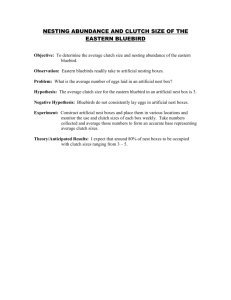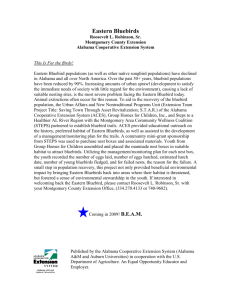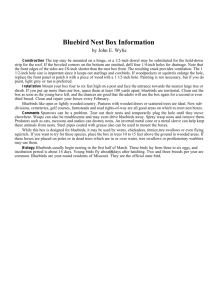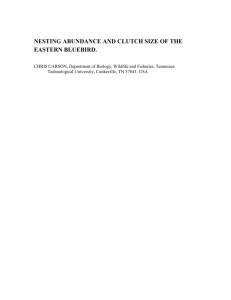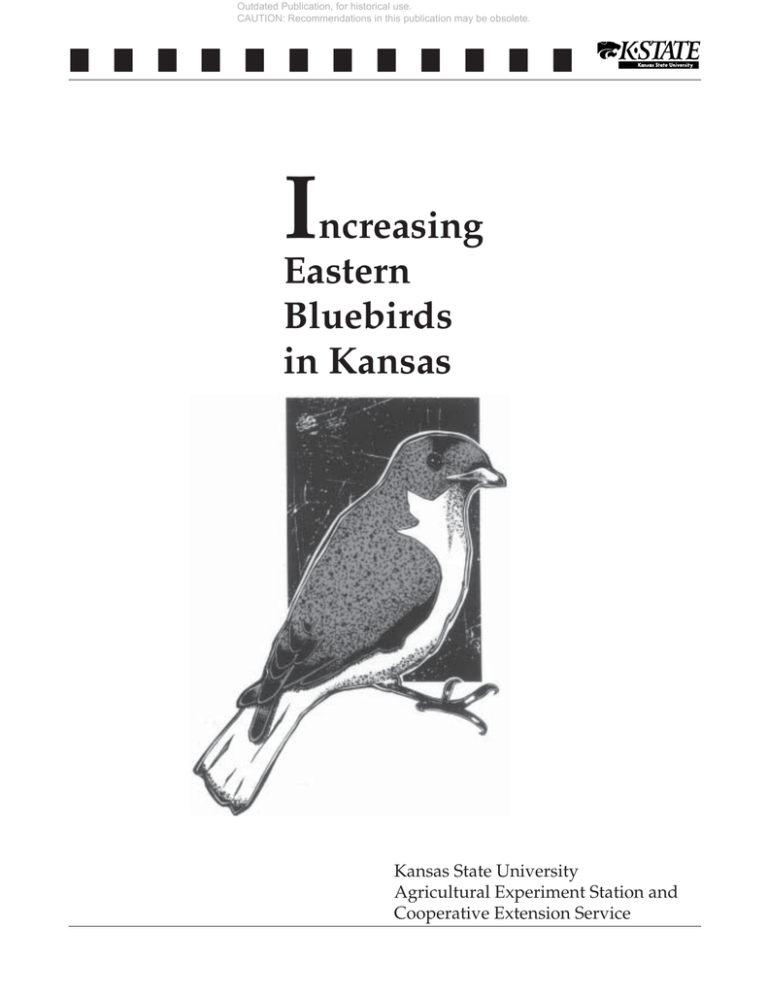
Outdated Publication, for historical use.
CAUTION: Recommendations in this publication may be obsolete.
■ ■ ■ ■ ■ ■ ■ ■ ■ ■ ■ ■ ■ ■ ■
IEastern
ncreasing
Bluebirds
in Kansas
Kansas State University
Agricultural Experiment Station and
Cooperative Extension Service
Increasing Eastern Bluebirds — 1
Outdated Publication, for historical use.
CAUTION: Recommendations in this publication may be obsolete.
■ ■ ■ ■ ■ ■ ■ ■ ■ ■ ■ ■ ■ ■ ■
Increasing Eastern Bluebirds — 2
Outdated Publication, for historical use.
CAUTION: Recommendations in this publication may be obsolete.
■ ■ ■ ■ ■ ■ ■ ■ ■ ■ ■ ■ ■ ■ ■
Increasing
Eastern Bluebirds
in Kansas
Natural History
B
luebirds can bring a lot of joy and beauty into our
lives. Early settlers called the eastern bluebird the harbinger of spring or blue robin because of its chestnut orange
breast and iridescent-blue back and tail. One of Kansas' common resident passerine birds, this strikingly elegant bird is
admired most for its beauty, gentle disposition, family devotion, and delightful call. Also, it is easily attracted to home
and farm surroundings when nesting structures are constructed and placed correctly.
However, the eastern bluebird population has declined drastically, not only in Kansas but also nationwide. Estimates run as
high as 90 percent fewer in the last four decades. A major
cause is the decrease in nesting sites. Bluebirds are cavity
nesters whose natural nesting sites are tree holes they do not
make themselves. Clearing land, using fewer wood fences,
and eliminating dead trees have destroyed many cavity nesting sites.
Another major detriment to bluebirds is the overwhelming
competition from non-native starlings and house sparrows.
Bluebirds are rural and do not nest in cities or towns, although occasionally they will nest on the edges of small
towns.
There are ways to increase bluebird numbers. One way is to
provide nesting boxes, an effort underway nationwide. Kansans would benefit greatly from participating in this effort.
Increasing Eastern Bluebirds — 3
Because bluebirds prefer a mixture
of open grasslands and scattered
trees and shrubs, they are often
called a forest “edge” species.
Appropriate bluebird grassland
habitat consists of open meadows,
pastures, yards, cemeteries, parks,
and highway right-of-ways. Bluebirds also exist in old orchards and
cutover woodlands.
In these habitats they consume
grasshoppers, flying insects,
beetles, and caterpillars during
short forays to the ground from an
elevated perch during the summer.
During winter they travel in flocks,
feeding primarily on berries or
fruits.
The eastern bluebird’s breeding
season in Kansas extends from
March through July, although the
birds occasionally may initiate
nesting into August. Peak breeding
activity in Kansas begins in April.
Normally, bluebirds raise two to
three broods per year, often using
the same nesting site each time.
The female selects a proper nesting
site 4 to 6 feet above ground in a
natural cavity or hole excavated by
another animal. The nest is a neat,
cup-shaped structure made of fine
grass. The female lays one egg per
day for 4 to 6 days and incubates
the pale blue eggs for 12 to 14 days.
Outdated Publication, for historical use.
CAUTION: Recommendations in this publication may be obsolete.
■ ■ ■ ■ ■ ■ ■ ■ ■ ■ ■ ■ ■ ■ ■
Trailway Plans for Homesteading the Bluebird in Kansas
Wymore, NE
Marysville
Waterville
Blue Rapids
Randolph
Riley
Junction City
Bennington
18
Alta Vista
Chapman Council Grove
Strong City
24
Cottonwood Falls
Matfield Green
Cassoday
Augusta
77
El Dorado
Douglas
Winfield
Arkansas City
Oklahoma State Line
In eastern Kansas, the proposed bluebird corridor follows Highway 77 north to south. Another section
follows Highways 18 and 24 west to east from Bennington to De Soto. (See explanation on page 3.)
Soon after hatching, the fledglings
sprout feathers. At this time, they
have gray backs coupled with
spotted white breasts and only a
hint of blue in the wing and tail
feathers. Young birds remain in the
nest from 15 to 18 days.
After they leave the nest, the male
is in charge of the fledglings. He
feeds the growing birds and teaches
them how to obtain food. This
training continues for several days
until the youngsters can feed
themselves. During this time the
female is busy constructing a new
nest for the second or third brood.
How You Can Help
Perhaps the most severe problem
facing bluebirds today is the lack of
suitable nesting sites. Allowing
trees to mature and develop natural
nesting cavities is a lengthy process.
However, humans can speed it up
by providing artificial nest boxes.
Bluebirds readily accept manmade
nest boxes and, in some cases,
prefer them to natural cavities.
These boxes are easy to build, set
up, and maintain.
Bluebirds appear to be site-specific
in their acceptance of artificial
nesting structures. This publication
provides plans for four different
styles of nest boxes: Zeleny, Davis,
Increasing Eastern Bluebirds — 4
Slot, and Bleach Bottle. Bluebird
houses can be purchased or built.
Building and providing nest boxes
for songbirds can be rewarding for
people of all ages. The ease of
building and maintaining makes
this hands-on activity a good
educational experience in avian
biology for youth clubs, classes,
and individuals. This can also be a
successful money-generating
project if you sell the boxes. Also
helpful is a videotape showing
different types of bluebird houses,
their placement, and maintenance.
It is available through your nearest
county Research and Extension
office.
Outdated Publication, for historical use.
CAUTION: Recommendations in this publication may be obsolete.
■ ■ ■ ■ ■ ■ ■ ■ ■ ■ ■ ■ ■ ■ ■
Groups wishing to have a program
on the bluebird house project can
contact the Research and Extension
Wildlife Office, Room 128, Call
Hall, Kansas State University,
Manhattan, Kansas 66506-1600.
Telephone number is (785) 532-5654.
Nest Box Construction
Materials
Select durable, weather-resistant
materials because a properly
constructed nest box should last 10
to 15 years. Most kinds of lumber or
exterior plywood are satisfactory.
The most durable woods for nest
box construction are red cedar,
redwood, bald cypress, and red or
white oak. These are usually
expensive and tend to split when
nails are driven into them without
pre-drilled holes. Spruce, pine, or
hemlock are less durable, but are
easier to work with and are less
expensive. Exterior grade 1⁄2 to 3⁄4
inch plywood, called T-11, may be
used in place of lumber. This
material weathers well and is often
used for siding on homes. Because
it does not warp easily, it may be
used as a roof when other lumber is
used on the rest of the box.
Boxes can be constructed of new or
old lumber. Those constructed of
old lumber are less noticeable,
already weathered, and probably
less expensive. You can build nest
boxes of either rough or smooth
(planed) lumber. Do not use wood
treated with preservatives such as
creosote or pentachlorophenol
(penta). Some people get wooden
crates used for shipping grapes at
local grocery stores. This wood is
reportedly useful for constructing
nest boxes.
Properly constructed houses
encourage bluebirds to homestead
Kansans have proposed creating a
bluebird corridor. They would like
to place and maintain bluebird
nests north and south through
Kansas 25 miles on either side of a
line from Marysville to Arkansas
City. A bluebird corridor also runs
along Highways 18 and 24 from
Bennington east. Within that area, it
may be possible to have an experienced bluebird person meet with
your group and explain their
enjoyment and success in helping
the bluebird population in Kansas.
Several retired persons have agreed
to speak to groups. The Research
and Extension Wildlife office will
make arrangements and schedules.
Individuals and groups wishing to
establish bluebird trails, (a series of
bluebird houses in a line spaced at
least 300 yards apart), can seek additional information and possibly
special funds by contacting the
Kansas Department of Wildlife and
Parks, Non-game Program, P.O.
Box 1525, Emporia, Kansas 66801.
Figure 2. Bluebird House (after Davis)
Increasing Eastern Bluebirds — 5
Outdated Publication, for historical use.
CAUTION: Recommendations in this publication may be obsolete.
■ ■ ■ ■ ■ ■ ■ ■ ■ ■ ■ ■ ■ ■ ■
Use dry wall screws, wood screws,
corrugated underlayment nails, or
galvanized nails. Common or
smooth nails are unsatisfactory
because they do not hold well. Concrete coated, ring shank, or roughened shank nails are recommended
for boxes constructed of cedar or
redwood.
Move the door back and forth
several times so it will move easily.
If the house is to be placed on a
fence, drill four holes in the back
above and below the box and place
galvanized wire through them to
allow for hanging. Wire the box
firmly to the metal post.
It is unnecessary to paint nest boxes
— exterior finishing may please the
builder more than the occupant.
Unpainted boxes made of cedar,
redwood, bald cypress, or oak will
weather naturally and turn gray,
blending with their surroundings. If
you paint the boxes, select a waterbased exterior latex paint. Use light
color, green, gray or tan, to prevent
overheating of eggs or young. Oilbased stains used on homes and
fences also may be used, but do not
use paints containing lead or
chemical preservatives. Apply
finishes only to exterior surfaces.
Construction of Traditional
Zeleny Nest Box
(After Zeleny 1976)
Cut pieces shown in Figure 3.
Measure and mark a point approximately 2 inches from the top of the
front and back pieces. Using nails,
fasten one side on the top and
bottom to the front and back pieces.
On the other side, fasten the side
door with nails at the marked
points on the front and back.
Construction of Kentucky
Bluebird House
(After Davis 1988)
Cut the pieces shown in Figure 2.
Measure and mark a point approximately 2 inches from the top of each
side. Using nails, fasten the door to
each side at the top only. Be sure to
leave about 1⁄2 to 3⁄4 inch of the door
below the sides.
Using nails or screws, fasten the
front and sides to the back.
Measure carefully 1 1⁄8 inch from the
top of the box. Mark each side on
front and nail the entrance strip to
the box. The opening size is critical
because an entrance much larger
than 1 1⁄2 inch will allow starlings to
enter. Bluebirds will not use an
entrance with a smaller opening.
Drive a 6d finishing nail into the
side and bend it across the front to
act as a latch.
Figure 3. Bluebird House (after Zeleny)
Increasing Eastern Bluebirds — 6
Outdated Publication, for historical use.
CAUTION: Recommendations in this publication may be obsolete.
■ ■ ■ ■ ■ ■ ■ ■ ■ ■ ■ ■ ■ ■ ■
Do not nail at the bottom of this side.
Fasten this section to the back using
nails or screws.
Fasten the top and bottom pieces.
Recess the bottom piece approximately 1⁄4 inch up.
Drive a 6d nail into the side and
bend to act as a latch.
Move the door back and forth
several times so it will move easily.
Top Slot Opening
Nest Boxes
Wildlife researchers in Iowa tested
various models and found that a
box with a front slot opening was
used more successfully and more
often than the traditional circular
opening. These boxes are easier to
construct and maintain. The box is a
standard square with inside dimensions of approximately 5 x 5 x 10
inches, (see Figure 4). Instead of a
hole in the front of the box, a gap of
1-3⁄16 inch is left just below the roof.
This creates a slot across the front of
the box.
Figure 4. Bluebird House (slot type)
Bleach Jug Bluebird House
An inexpensive bluebird house can
be built from 1-gallon plastic bleach
jugs, (see Figure 5). Holes can be
drilled for air vents and wire
fasteners. A clean-out door can be
cut in one side near the bottom and
by using duct tape the door can be
held shut. Use duct tape over the
bottom and top edges of the 1 1⁄2inch hole cut for the entrance.
When using a plastic jug for a
bluebird house it is important to
paint the outside of house with at
least two coats of paint. (light grey
or tan is preferred.) This helps cool
the house. Further cooling should
be provided by a flat roof. Houses
can be individually numbered for
identification in your records.
Figure 5. Bleach Jug Bluebird House
Increasing Eastern Bluebirds — 7
Outdated Publication, for historical use.
CAUTION: Recommendations in this publication may be obsolete.
■ ■ ■ ■ ■ ■ ■ ■ ■ ■ ■ ■ ■ ■ ■
Modifications
If house sparrows are common in
your area, you may want to modify
the above designs by placing a strip
of 1⁄4 inch painted plexiglass or
hardware cloth on the top of the
bleach jug model. Sparrows like
dark nesting areas and may not use
structures that let more light enter.
Installation
Mount nest boxes on fence posts,
metal posts, utility poles, buildings,
or fences 4 to 6 feet above ground.
The preferred mounting site is a
metal post. The next choice is a
wooden post. A utility pole is also a
good site, but remember to get
permission from the utility company before erecting any boxes.
Tree trunks are less desirable
because bluebirds show a definite
preference for boxes on posts. In
addition, boxes on trees are more
susceptible to damage by squirrels,
predation by cats and snakes, and
use by mice and flying squirrels.
Fences are excellent sites if the box
is on the side away from cattle.
Otherwise, cattle will rub on a box
and knock it down. Horses will
reach across a fence and chew the
box unless a barbed wire is stretched across the top. Near horse
pastures, put the box low enough to
be beyond the reach of the horse,
but not easily accessed by cats. The
preferred option in this situation is
toerect a metal post outside the
fence.
Predators like house cats, raccoons,
and snakes will readily eat the eggs
and young in a bluebird house.
Make it difficult for predators to get
into them by placing the boxes on
metal posts. Coating the post with
grease may further discourage
predators and ants. Another
method of reducing predation is to
place a cone-shaped metal shield
just below the box. Paint metal
predator guards with a flat paint to
reduce glare.
Hornets and/or yellow jackets
often build their nest in bluebird
houses. Vaseline or other odorless
petroleum jellies will keep these
creatures out when applied inside
on the lower surface of the nest box
top. Also, by placing the nest boxes
at least 300 yards away from
buildings, house sparrows use of
nest boxes will be greatly reduced.
Location
Spacing of boxes is essential
because birds have and defend
territories during the nesting
season. The spacing pattern will be
dictated by the arrangement of
food, cover and isolation in any one
locality. Place the boxes 100 to 300
yards or more apart in areas where
trees, shrubs, fences, or utility wires
are present. These structures
provide perching sites for feeding.
Boxes placed near woods, brush
piles, or aquatic areas often attract
other bird species such as chickadees, titmice, wrens, nuthatches, or
tree swallows. Do not discourage
these species from nesting because
they are welcome additions to
the area and eat large numbers of
insects. House sparrows may take
over the boxes. Because this species
is not protected by Federal or State
laws, these eggs and young can be
removed. By repeatedly removing
nest eggs or young, you can discourage nesting by sparrows. If
house sparrows evict bluebirds,
quickly erect another box nearby.
Bluebirds will not return to the
boxes sparrows have taken over,
but they will quickly find an empty
box in the vicinity. The eviction is a
minor setback to the bluebirds if
another box is available.
Maintenance
. . . you have your best
chance of getting tenants if
you put boxes up by the end
of February.
Boxes can be erected at any time.
However, you have your best
chance of getting tenants if you put
them up by the end of February
when the bluebirds start searching
for nesting locations. The birds will
use boxes erected as late as August.
Place the boxes in suitable habitat
including areas where insects
abound and where there is a
mixture of trees and open grassland. Open fields, cemeteries,
pastures, golf courses, gardens, and
large lawns can all be appro-priate
habitat. Try to avoid placing the
boxes in areas where insecticides
are heavily used. Often, several
boxes in good locations may be
necessary to attract one pair of
birds.
Increasing Eastern Bluebirds — 8
Nest boxes should be inspected,
cleaned, and repaired periodically.
By late February each year, boxes
should be cleaned of debris, drains
opened, and any structural repairs
made. During the nesting season,
frequent inspection may be required
to prevent house sparrows from
using nest boxes. Bluebirds do not
seem to mind if you look in their
nest; they will not desert it.
The bluebird’s nesting material will
be composed of small cuttings of
grass, and fine roots. The house
sparrow will fill the nest with any
kind of material that is loose. This
includes feathers, string, paper,
sticks and grass. Remove the nests
built by sparrows as often as is
necessary and dispose of that
material away from the nest site.
Leave old nesting material in the
box during the winter to provide
insulation for birds taking refuge in
the boxes during cold, winter nights.
Outdated Publication, for historical use.
CAUTION: Recommendations in this publication may be obsolete.
■ ■ ■ ■ ■ ■ ■ ■ ■ ■ ■ ■ ■ ■ ■
Evaluation
tion.
Enhancing Bluebird Habitat
It might be interesting and fun to
set up an experiment to evaluate
which nesting boxes birds use the
most and how many young are
produced each year. It is not necessary to check the boxes; however,
amateur ornithologists have contributed greatly to our understanding of bird ecology and behavior.
When checking the boxes, be careful
not to disturb the nest, eggs, or
young. Gently tap on the top of the
box before opening to allow the
female to leave. She will return after
a short absence. After opening,
examine for signs of nest building,
eggs, young, or other activity.
You can improve bluebird habitat,
and songbird habitat in general, by
planting a variety of shrubs and
trees in your yard or garden. The
bluebird’s diet is composed largely
of insects, although they do eat
substantial amounts of fruits and
berries during the winter. A variety
of birds will benefit from these
plantings.
Begin visitations in mid-March and
continue throughout the summer.
Boxes should be checked every 7 to
14 days. During the egg laying
period, do not disturb the female in
the morning. When you observe
near completion of nest construction, check the box in the afternoon.
Do not disturb young birds after
they are about 12 days old (near the
time of leaving the box) at any time
during the day. Disturbance during
this period may cause the young to
leave prematurely and result in
death due to starvation or preda-
It is important to keep good records
of the number of boxes containing
nests, which bird species are
utilizing the boxes, number of boxes
with eggs, and how many young
are hatched. More detailed information on the number of eggs per
clutch, approximate hatching date,
number of eggs hatched, number of
young surviving, number of nestlings fledged, approximate time of
fledgling and probable causes of
nest, egg, or young loss can also be
recorded.
Trees
Shrubs
Oaks
Cherry
Hackberry
Crabapple
Pines
Spruces
Cedar
Mulberry
Dogwoods
Sumacs
Honeysuckle
Raspberry
Blackberry
Serviceberrry
Inkberry, hollies
Viburnum
Bittersweet
Cyraeautha
Further Reading
■ The Bluebird: How You Can Help
its Fight for Survival, by Lawrence
Zeleny. 1976. Indiana University
Press, Bloomington, Indiana.
170 pp.
■ A Field Guide to Birds East of the
Rockies, by Roger Tory Peterson.
1980. Houghton Mifflin Company,
Boston. 384 pp.
■ The Audubon Society Master Guide
to Birding. Vol. 3, Old World
Warblers to Sparrows. Edited by
John Farrand, Jr. 1983.
Alfred A. Knopf Inc., New York,
400 pp.
■ Field Guide to the Birds of North
America. 1983. National Geographic
Society, Washington, D.C. 464 pp.
Increasing Eastern Bluebirds — 9
■ A Guide to Field Identification:
Birds of North America. 1983. Golden
Press, New York. 360 pp.
■ Sialia, Official quarterly publication of the North American Bluebird Society, Box 6295, Silver Spring
MD 20906.
Outdated Publication, for historical use.
CAUTION: Recommendations in this publication may be obsolete.
Season Record of Monitoring
Legend:
BN= Bluebird nest
BE = Bluebird eggs
BH= Bluebirds hatched
BF = Bluebirds fledged
SN
VAN
PD
OBN
=
=
=
=
Sparrow nest removed
Vandalism
Predator damage
Other bird nesting
Bluebird House
Date
1
2
3
4
5
6
7
8
9
10
11
12
Outdated Publication, for historical use.
CAUTION: Recommendations in this publication may be obsolete.
■ ■ ■ ■ ■ ■ ■ ■ ■ ■ ■ ■ ■ ■ ■
Printing of this publication was provided from Renewable Resources
Extension Act Funds.
Acknowledgment
The authors used material written by Thomas G. Barnes, Extension Wildlife Specialist, Department of Forestry, College of Agriculture, University of Kentucky, Lexington, KY 40546-0073. The Extension publication Forestry Department, Number 2
entitled, “Eastern Bluebirds - Nesting Structure Design and Placement” has been
used as a guide for this publication. Thanks to Dr. Barnes and the Cooperative
Extension Service at the University of Kentucky for permission to adapt this material for use in Kansas. Collectively, the authors of this publication have added
useful information gained by developing bluebird nesting sites in Kansas.
Authors
F. Robert Henderson
Extension Specialist
Animal Damage Control
Department of Animal Science
and Industry
Kansas State University, Manhattan
Marvin Schwilling
Wildlife Biologist
Kansas Department of
Wildlife and Parks, Emporia
Wes Seyler
Bluebird Project Committee Member
Lawrence
Otis H. Darrow
Bluebird Project Committee Member
Topeka
Eugenia L. Fittell
Bluebird Project Committee Member
Topeka
E.S. Bagley
Bluebird Project Committee Member
Manhattan
Brand names appearing in this publication are for product identification purposes only. No endorsement is intended,
nor is criticism implied of similar products not mentioned.
Publications from Kansas State University are available on the World Wide Web at: http://www.oznet.ksu.edu
Contents of this publication may be freely reproduced for educational purposes. All other rights reserved. In each case, credit
F. Robert Henderson et al., Increasing Eastern Bluebirds in Kansas, Kansas State University, November 1990.
Kansas State University Agricultural Experiment Station and Cooperative Extension Service
C-720
November 1990
It is the policy of Kansas State University Agricultural Experiment Station and Cooperative Extension Service that all persons shall have equal opportunity and
access to its educational programs, services, activities, and materials without regard to race, color, religion, national origin, sex, age or disability. Kansas State
University is an equal opportunity organization. Issued in furtherance of Cooperative Extension Work, Acts of May 8 and June 30, 1914, as amended. Kansas
State University, County Extension Councils, Extension Districts, and United States Department of Agriculture Cooperating, Marc A. Johnson, Director.
File code: Wildlife 4–2

